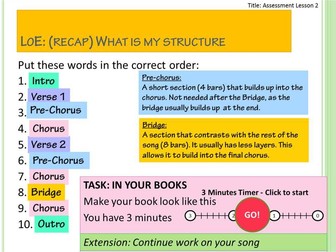African Drumming Complete SOW with non-drumming tasks
This is a 5 week course in African drumming, Perfect for the shorter 1/2 terms after Christmas for year 8 or 9 (I wrote it with yr 8's in mind). In this file there are two variations, for higher and lower level of musical ability as well as some built in class routines, and a bank of progressive activities to resort to (using books and/or computers), should you feel that the class needs to take a break from the drums. Assessment can be done during the final masterpiece, I have not included assessment levels, as I am aware that many schools have very different systems.<br />
<br />
The SOW gets students composing, improvising and layering rhythms in a Ghanaian drumming style. It highlights many keywords and their meanings, keywords that are usually left for GCSE have been highlighted where possible. These include everything from tempo and structure through to polyrhythm, resultant rhythm and the differences between time signatures<br />
<br />
All necessary rhythms are written in notation, and given rhythm-words on the powerpoint. The scheme is repeated twice within the file, one which highlights higher ability keywords for high sets, and one which is slightly reduced for the lower sets. This is accessible through hyperlinks on slide 1. All lessons have a 'stop drumming' button which, when pressed, zaps you to the non-drumming activities.<br />
<br />
In my school, the final performance piece was ideal for showing off gifted and talented students who improvised solos and took on the role of master drummer, whilst less able students are encouraged to participate by just being part of a group. We used it in a year 8 assembly, then we were requested to use it again in assemblies for all other year groups and to parents in our recent spring concert. It was a massive success and 100% of the students said that they really enjoyed it. I thoroughly recommend having a djembe and a djembe strap for teaching African drums, it allows you to walk around the room and simultaneously demonstrate/ join in.
